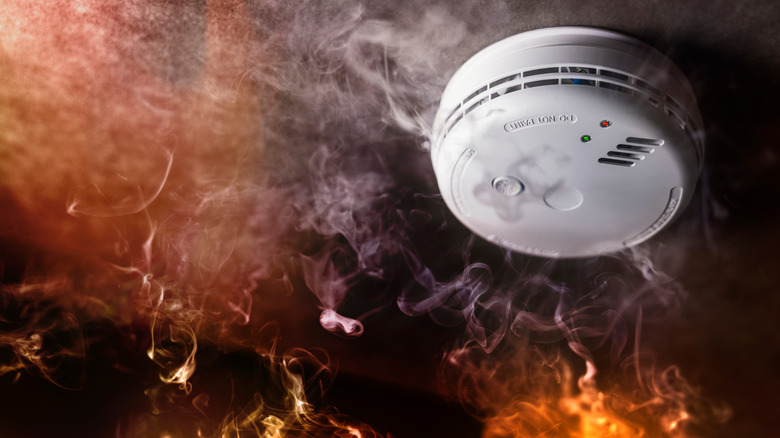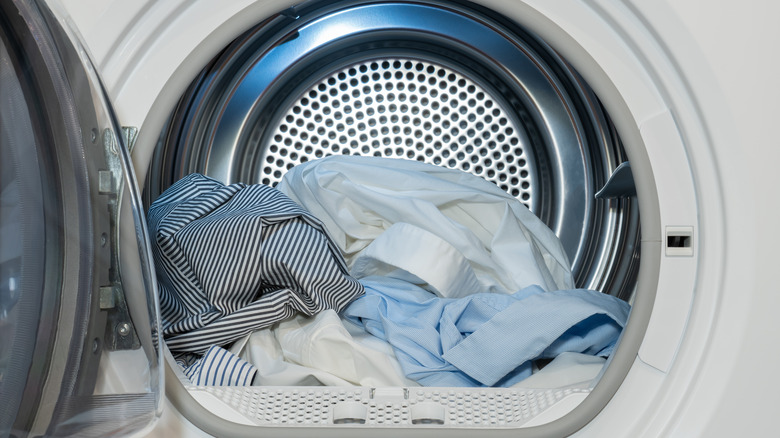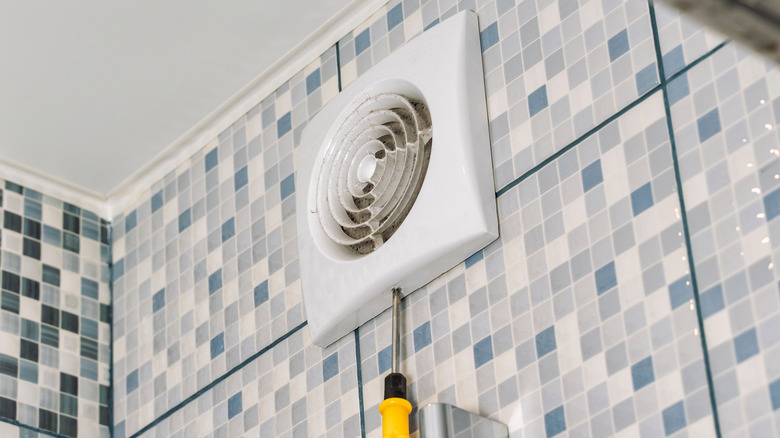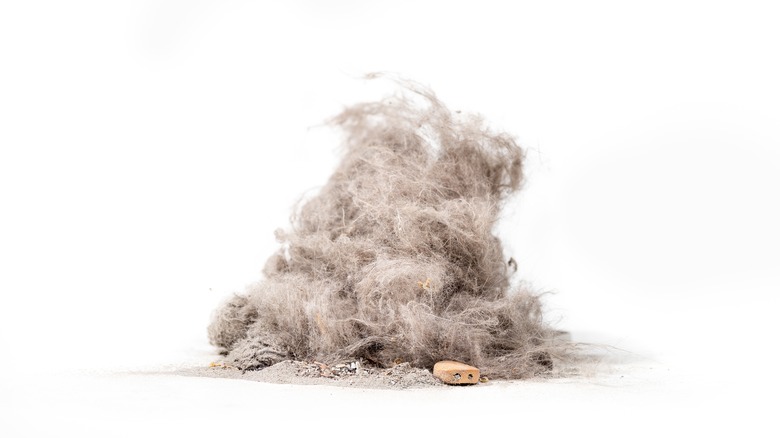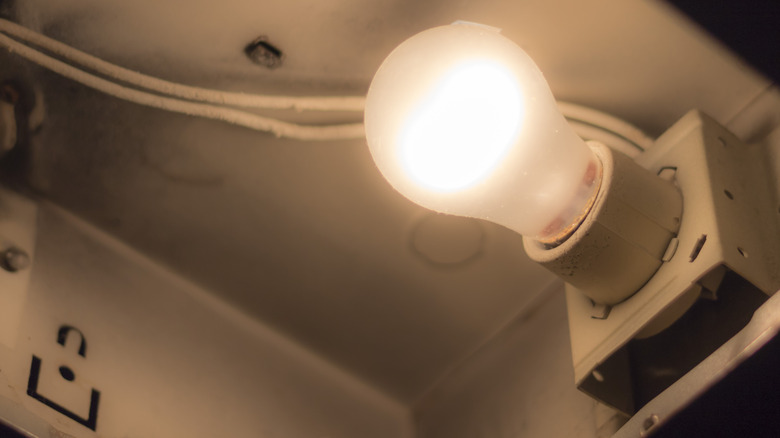4 Hidden Fire Hazards In Your House That You Need To Know About
Although in recent years, there has been a significant downward trend in the number of house fires, there are still close to 360,000 blazes annually, per The Zebra. One occurs an average of every 89 seconds, with a civilian fatality resulting roughly every two hours. Despite the decline in reported incidents, according to Policygenius, there has been a corresponding doubling of the property damage costs to the tune of $8.4 billion in 2020.
Potential home fire hazards abound, and obvious ones include careless cooking, wonky space heaters, and overloaded electrical outlets. Misusing Christmas tree lights and candles, as well as bad smoking habits, contribute to the fire count. Improper storage, static electricity, and faulty chimneys are also known culprits.
There are several less obvious and easy-to-overlook problem areas that require awareness, vigilance, and maintenance to avoid becoming fire hazards. Among them are a clothes dryer and its exhaust vent and bathroom and kitchen exhaust fans. So-called dust bunnies can ignite with disastrous results, and exposed lightbulbs, especially in a confined space such as a closet, can have deadly consequences. Bear in mind there might be a slim margin for error: A small flame can become an inferno in less than half a minute, warns Ready.
Clothes dryer and exhaust vent
This machine is a workhorse but also the source of an estimated 90% of appliance fires, the American Red Cross reports. Inspecting and cleaning the lint trap after each use is key to fire prevention (and will also ensure better performance). Monitoring lint buildup in the exhaust pipe and vents is another important step. Clothes dryers are responsible for nearly 14,000 home fires yearly, and lint is the villain in more than a quarter of them, Consumer Reports asserts.
To prevent lint from accumulating in the dryer's duct, a metal clamp will provide a firm connection. A once or twice a year dusting and vacuuming is recommended. A less-efficient drying cycle is a warning to clean before this routine maintenance. Before disassembling the duct to clean it, make sure to disconnect the dryer from the electrical outlet or disable the gas if applicable.
Switching from a typical accordion-style duct to a metal system is another way to minimize lint buildup. Consumer Reports points out that a clogged vent may set off an alert in newer dryer models, but a partially blocked one may not. Lint or dust should not be permitted to build up underneath the appliance, and a vent leading outdoors should never be blocked by snow. Instead of machine-drying clothes that have paint stains or other flammable spots, wash and then air dry.
Bathroom fans
A harmless-seeming bathroom fan is another hidden fire risk. Again, lint buildup is guilty, and faulty wiring or leaving the fan on too long can cause a fire, according to Först Consulting Corp. Anything hindering the blades from rotating freely can quickly result in overheating. If the motor conks out with the unit on, the current might not trip the circuit breaker but still be high enough to result in a fire, per CEP Forensic.
A bathroom fan needs to be examined often, and the faceplate and housing vacuumed, then cleaned with water and soap. Detaching the duct may also be required. Lint is combustible and may ignite if it impedes the smooth operation of the fan's rotors. A slow-starting or discolored fan, a burning or ozone smell, and odd sounds are signs of hazardous lint buildup, according to American Family Insurance. Toilet paper might also have been sucked in by the fan, snagging it. Once ignited, a fire can migrate through the ceiling. Items on the bathroom floor might also catch on fire from dripping, flaming plastic coming from the fan.
To avoid overheating, never leave a bathroom fan on for more than 20 or 30 minutes, and don't leave the house with it running. Use a timer switch or set an alarm to remind you of the safe time limit. Don't use an incandescent light with it — an LED light is better. Obsolete fans should be replaced with thermally insulated ones.
Hazardous dust bunnies
Dust bunnies are another underrated fire hazard that is easy to ignore until it is too late. Non Toxic For Health describes the disgusting dust clumps as a conglomeration of shedded skin, fallen hair, pollen, remnants of bugs, and dirt, all seasoned with dust mites. They form in clumps around power strips, electrical outlets, and appliances. Dust bunnies tend to congregate behind entertainment centers or any other area likely to be a dust collector, according to Sage Restoration.
They can be a fire hazard, especially near electronic equipment, and should not be near floor heaters or wall sockets. A spark is all it could take to ignite the mass of dust and debris. A regular routine of dusting and vacuuming is necessary to keep dust bunnies at bay. Underneath beds and furniture are other gathering places that need maintenance. In addition to being flammable, dust bunnies are harmful to your indoor environment. Ironically, chemical fire retardants on items get in the air and adhere to the dust bunnies, adding to their toxicity.
Replace exposed lightbulbs
Exposed incandescent bulbs were often seen in the closets of older homes or apartments. They used to be permissible provided they were situated at least 18 inches away from a shelf, states Structure Tech. This is no longer acceptable according to code, which is a good thing, as it is an electrical fire hazard. According to Halo Restoration Services, an incandescent 60-watt bulb will normally get no hotter than 175 degrees. If an exposed one is in a confined area such as a closet, it can exceed temperatures 2 to 3 times that, posing a threat to anything nearby that is combustible.
A halogen lightbulb is barely safer than the Edison bulb. Brecher's Lighting says both styles are capable of overheating due to the excessive percentage of electricity used to create heat: 97%. Conversely, an LED bulb poses less of a fire hazard because it absorbs much more of the heat it generates. Other measures to make an exposed bulb safer are to enclose it in a globe or substitute a luminaire, or complete lighting unit, as a replacement.
An uncovered lightbulb presents another potential risk, though not a fire-related one. If the bulb is in the kitchen or serving area, shards of metal or glass can drop into food and contaminate it. Covering the lightbulb with a mesh shield will eliminate the hazard, suggests Science Trends.

